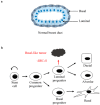BRCA1-Dependent Transcriptional Regulation: Implication in Tissue-Specific Tumor Suppression
- PMID: 30558184
- PMCID: PMC6316118
- DOI: 10.3390/cancers10120513
BRCA1-Dependent Transcriptional Regulation: Implication in Tissue-Specific Tumor Suppression
Abstract
Germ-line mutations in breast cancer susceptibility gene 1 (BRCA1) predominantly predispose women to breast and ovarian cancers. BRCA1 is best known for its functions in maintenance of genomic integrity including repairing DNA double-strand breaks through homologous recombination and suppressing DNA replication stress. However, whether these universally important BRCA1 functions in maintenance of genomic stability are sufficient to account for its tissue-specific tumor-suppressing function remains unclear. Accumulating evidence indicates that there are previously underappreciated roles of BRCA1 in transcriptional regulation and chromatin remodeling. In this review, we discuss the functional significance of interactions between BRCA1 and various transcription factors, its role in epigenetic regulation and chromatin dynamics, and BRCA1-dependent crosstalk between the machineries of transcription and genome integrity. Furthermore, we propose a model of how transcriptional regulation could contribute to tissue-dependent tumor-suppressing function of BRCA1.
Keywords: BRCA1; chromatin organization; epigenetic regulation; transcriptional regulation.
Conflict of interest statement
The authors declare no conflict of interest.
Figures



References
-
- Whittemore A.S., Gong G., John E.M., McGuire V., Li F.P., Ostrow K.L., DiCioccio R., Felberg A., West D.W. Prevalence of BRCA1 mutation carriers among US non-hispanic whites. Cancer Epidemiol. Biomark. 2004;13:2078–2083. - PubMed
-
- Antoniou A., Pharoah P.D.P., Narod S., Risch H.A., Eyfjord J.E., Hopper J.L., Loman N., Olsson H., Johannsson O., Borg A., et al. Average risks of breast and ovarian cancer associated with BRCA1 or BRCA2 mutations detected in case series unselected for family history: A combined analysis of 22 studies. Am. J. Hum. Genet. 2003;72:1117–1130. doi: 10.1086/375033. - DOI - PMC - PubMed
-
- Kuchenbaecker K.B., Hopper J.L., Barnes D.R., Phillips K.A., Mooij T.M., Roos-Blom M.J., Jervis S., van Leeuwen F.E., Milne R.L., Andrieu N., et al. Risks of breast, ovarian, and contralateral breast cancer for BRCA1 and BRCA2 mutation carriers. JAMA. 2017;317:2402–2416. doi: 10.1001/jama.2017.7112. - DOI - PubMed
Publication types
Grants and funding
LinkOut - more resources
Full Text Sources
Miscellaneous

